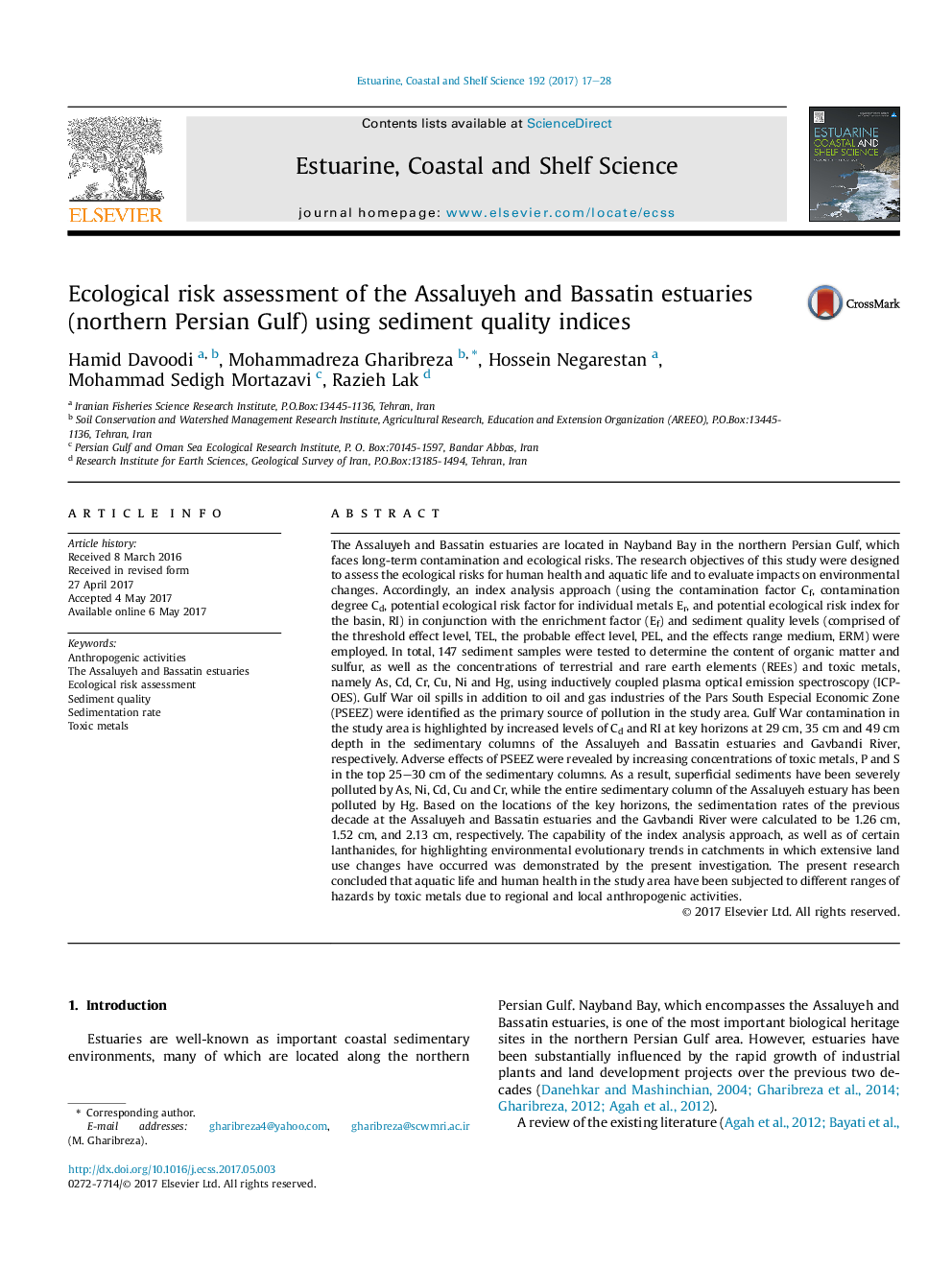| کد مقاله | کد نشریه | سال انتشار | مقاله انگلیسی | نسخه تمام متن |
|---|---|---|---|---|
| 5765160 | 1626610 | 2017 | 12 صفحه PDF | دانلود رایگان |
عنوان انگلیسی مقاله ISI
Ecological risk assessment of the Assaluyeh and Bassatin estuaries (northern Persian Gulf) using sediment quality indices
ترجمه فارسی عنوان
ارزیابی خطر زیست محیطی رودخانه های عسلویه و باساتین (شمال خلیج فارس) با استفاده از شاخص های کیفیت رسوب
دانلود مقاله + سفارش ترجمه
دانلود مقاله ISI انگلیسی
رایگان برای ایرانیان
کلمات کلیدی
فعالیت های انسان شناسی، دره های عسلویه و باساتین، ارزیابی ریسک زیست محیطی، کیفیت رسوب، سرعت رسوب، فلزات سمی،
موضوعات مرتبط
مهندسی و علوم پایه
علوم زمین و سیارات
زمین شناسی
چکیده انگلیسی
The Assaluyeh and Bassatin estuaries are located in Nayband Bay in the northern Persian Gulf, which faces long-term contamination and ecological risks. The research objectives of this study were designed to assess the ecological risks for human health and aquatic life and to evaluate impacts on environmental changes. Accordingly, an index analysis approach (using the contamination factor Cf, contamination degree Cd, potential ecological risk factor for individual metals Er, and potential ecological risk index for the basin, RI) in conjunction with the enrichment factor (Ef) and sediment quality levels (comprised of the threshold effect level, TEL, the probable effect level, PEL, and the effects range medium, ERM) were employed. In total, 147 sediment samples were tested to determine the content of organic matter and sulfur, as well as the concentrations of terrestrial and rare earth elements (REEs) and toxic metals, namely As, Cd, Cr, Cu, Ni and Hg, using inductively coupled plasma optical emission spectroscopy (ICP-OES). Gulf War oil spills in addition to oil and gas industries of the Pars South Especial Economic Zone (PSEEZ) were identified as the primary source of pollution in the study area. Gulf War contamination in the study area is highlighted by increased levels of Cd and RI at key horizons at 29Â cm, 35Â cm and 49Â cm depth in the sedimentary columns of the Assaluyeh and Bassatin estuaries and Gavbandi River, respectively. Adverse effects of PSEEZ were revealed by increasing concentrations of toxic metals, P and S in the top 25-30Â cm of the sedimentary columns. As a result, superficial sediments have been severely polluted by As, Ni, Cd, Cu and Cr, while the entire sedimentary column of the Assaluyeh estuary has been polluted by Hg. Based on the locations of the key horizons, the sedimentation rates of the previous decade at the Assaluyeh and Bassatin estuaries and the Gavbandi River were calculated to be 1.26Â cm, 1.52Â cm, and 2.13Â cm, respectively. The capability of the index analysis approach, as well as of certain lanthanides, for highlighting environmental evolutionary trends in catchments in which extensive land use changes have occurred was demonstrated by the present investigation. The present research concluded that aquatic life and human health in the study area have been subjected to different ranges of hazards by toxic metals due to regional and local anthropogenic activities.
ناشر
Database: Elsevier - ScienceDirect (ساینس دایرکت)
Journal: Estuarine, Coastal and Shelf Science - Volume 192, 5 June 2017, Pages 17-28
Journal: Estuarine, Coastal and Shelf Science - Volume 192, 5 June 2017, Pages 17-28
نویسندگان
Hamid Davoodi, Mohammadreza Gharibreza, Hossein Negarestan, Mohammad Sedigh Mortazavi, Razieh Lak,
